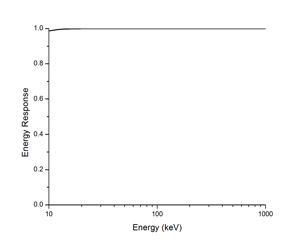


There is a strong need for major improvement in nuclear detector devices. One strategy is to identify new scintillator materials of significantly higher efficiencies. To date, materials exploration has been semi-empirical in nature. Our research program is designed to focus on some of the fundamental relationships between energy response and certain material characteristics leading to algorithms for making materials design more systematic and successful.
This research program is focused on improving the energy resolution of scintillator materials and includes:
- Development of relationships between a scintillator's crystal structure and chemistry and its non-proportionality of response. Studies involve use of model materials systems, and attempts to understand the effect of changes in interatomic spacing and band structure on non-proportionality.
- Development of a model for evaluating the potential linearity of response of novel scintillator materials based on composition and crystal structure.
- Prediction, fabrication, and characterization of novel scintillator materials which exhibit improved linearity of response and intrinsic energy resolution.
- Generation of fundamental knowledge related to intrinsic energy resolution to promote the identification of more efficient scintillation materials for nuclear threat detection.
- Training of students in the fields of scintillator and materials science and technology.

The experimental objectives of this program will be accomplished through a pioneering systematic-study of the energy response of scintillator materials under conditions through which the crystal structure will be distorted. These distortions are expected to modify the band structure, including the band-gap and the conduction-band dispersion, thereby influencing the energy loss mechanisms involved in the scintillation process.The experimental approach of this program relies on the innovative combination of two techniques:
- Crystal-structure distortions in model compounds by employing compositional variations, an applied pressure, or, in the case of compounds which are both scintillating and piezoelectric, an applied external electrostatic field.
- Characterization of the energy response of selected materials by the Compton Coincidence Technique (CCT).
Throughout the program, a prominent computational component will dynamically complement the experimental activities through band structure calculations.These studies will be carried out on both well-established (e.g. BGO, YAP, LaBr3) and emerging (e.g. BaHfO3, SrHfO3, SrI2) scintillator materials. Another unique aspect of this program is the study of the non-proportionality of transparent ceramic scintillators in addition to single-crystals, particularly LiBaF3 and SrI2.




Project Title:
A Structural Chemistry Approach to Non-proportionality Studies in Ceramic and Single Crystal Scintillators:
Towards Improved Energy Resolution for Nuclear and Radiological Detectors
Sponsor:
Domestic Nuclear Detection Office/Department of Homeland Security
Program Effective Dates:
November 2007 to November 2012
Principal Investigator:
Prof. Robert S. Feigelson, Dept. of Material Science & Engineering and Geballe Laboratory for Advanced Materials. (Stanford University)
Staff:
Dr. Martin Gascon (Stanford University)
Students:
Stephanie Lam (Stanford University)
Collaborators:
Prof. Stefano Curtarolo (Co-Principal Investigator), (Duke University)
Dr. Wahyu Setyawan (Pacific Northwest National Laboratory)
Prof. Romain Gaume (University of Central Florida)
Dr. Edith Bourret (Lawrence Berkeley Laboratory)
Dr. Steven Payne, Dr. Nerine Cherepy (Lawrence Livermore National Laboratory)